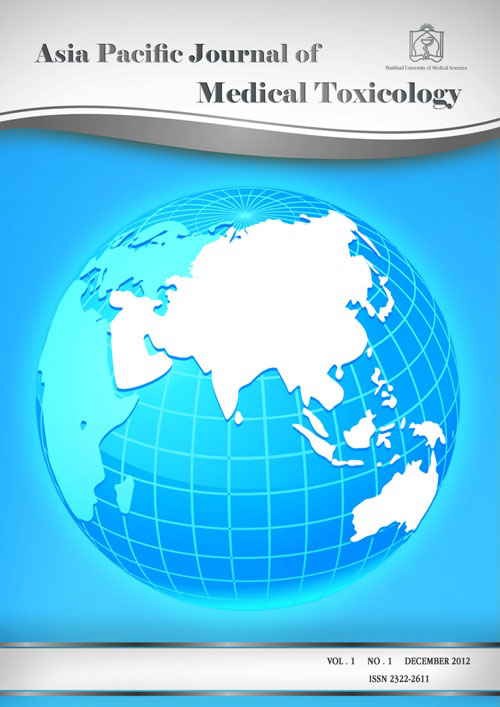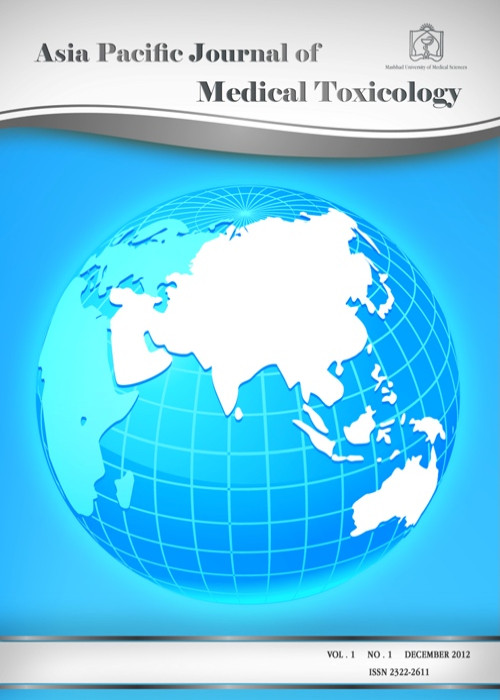فهرست مطالب

Asia Pacific Journal of Medical Toxicology
Volume:6 Issue: 4, Autumn 2017
- تاریخ انتشار: 1396/10/30
- تعداد عناوین: 8
-
-
To What Extent Vital Signs Are Important to Medical Toxicologists When Conflicts Arise in Defining ToxidromsPage 104
-
Pages 105-108BackgroundTramadol intoxication and its non-therapeutical abuse have recently become prevalent in Iran. Tramadol overdose cases may be complicated by some neurologic incidences such as seizure. In this study, we aimed to evaluate possible central neural system lesions in patients with tramadol-induced seizure using MRI imaging.MethodsA cross-sectional study was conducted with age- and sex-matched case and control groups. The case group included oral tramadol intoxication cases with loss of consciousness and/or tramadol induced seizure. The control group included patients with seizure without tramadol consumption. The brain MRI was done in the first post-seizure 24-hour. Finally, all data were analyzed using SPSS software.Results15 patients (7 females and 8 males) were in the control group and 15 patients (3 females and 12 males) were in the case group with mean age of 22.27±6.54 and 21.93±4.57 years, respectively. 8 patients of case group and 3 patients of control group had abnormal evidence (hyper signal foci in white matter) in brain MRI images; there was no significant difference between the two groups (P=0.128). Lesions depth in MRI images of the case group were equally in Subcortical and Deep parts of the white matter (37.5%) and in 2 cases (25%) were observed in both parts. There was no difference between the two groups in this regard (P=0.721).ConclusionIn our study, over half of the case group patients had hypersignal but nonspecific evidence in MRI imaging. No significant difference was observed between case and control groups in the lesions pattern.Keywords: Brain, Magnetic Resonance Imaging, Poisoning Tramadol
-
Pages 109-114BackgroundNon-accidental poisoning in the paediatric age group is uncommon and international literature on this subject is limited. There are no Sri Lankan paediatric studies on non-accidental poisoning to date. The objective of the current study was to explore the predisposing factors and profile of children less than 12 years in rural Sri Lanka who had non-accidental poisoning.MethodThis cross-sectional study was conducted at Anuradhapura teaching hospital for two years (from February 2012 to January 2014) involving all children below 12 years and presented with either a history of acute non-accidental self-poisoning or non-accidental poisoning by another person. Quantitative data were collected using a structured questionnaire and qualitative data to explore the background socio-cultural factors were collected using focused group discussions. Both quantitative and qualitative data were analysed separately in the two groups.ResultsNineteen children with non-accidental poisoning were recruited among 383 acute poisoning admissions over two years. The majority of children were male 13 (68.4%). All children who had non-accidental self-poisoning were at least eight years of age while the mean age of children poisoned by another person was 4.6 years. Children mostly ingested pesticides (9/14- 64.3%) followed by plant poisons and medicinal poisons. No child was reported to have ingested household chemicals including kerosene oil or miscellaneous substances intentionally. Children with non-accidental self-poisoning often had acute psychological distress and an immediate preceding event which resulted in the poisoning event. Verbal abuse by parents, poor family relationships, psychiatric disorders in children and emotional disturbances were often predisposing factors. Four children had morbidity secondary to aspiration pneumonia, respiratory arrest, and cardiac arrhythmias. Case fatality rate was 14.3% among children with non-accidental self-poisoning. Children with non-accidental poisoning by another person often did not have acute psychological distress prior to the poisoning event. When the perpetrator was one of the parents, those families had major disruptions in family relationships and functioning.ConclusionNon-accidental poisoning in paediatric age could be either non-accidental self-poisoning or non-accidental poisoning by another person. The risk factors for the two types of non-accidental poisonings are different and multitudinous. These predisposing factors need to be further evaluated through community-based studies.Keywords: Children, Poisoning, Sri Lanka
-
Pages 115-117BackgroundDeliberate self-harm (DSH) is a global problem which has steadily increased over the past few years in developing countries and has become as one of the major causes of morbidity and mortality in these countries. The aim of this prospective study was to analyze the prevalence of organophosphate poisoning among other acute DSH cases admitted to the medical ward at Batticaloa Teaching Hospital, Sri Lanka. We report the socio-demographic, and outcome of organophosphate poisoning.MethodThe prospective study comprises of 121 cases of acute poisoning admitted at Batticaloa Teaching Hospital (BTH), Sri Lanka. This study was conducted for a period of three months from April 12 through July 12, 2017.ResultsAmong the subjects, 119 (98.34%) cases had intentional poisoning and only two cases (1.65%) accidental poisoning. Poisoning with organophosphate compounds (OP) 23 (19%) was the second leading type. There were 13 (56.5%) males and 10 (43.5%) females. Most of the patients were under the age group of 20-29 years old. 21 cases lived in rural areas and 2 in urban areas. Out of 23 patients, there were 2 (8.7%) deaths, 18 (78.3%) were discharged without any complications.ConclusionDSH in Sri Lanka is reported to be associated with interpersonal conflict, short premeditation, as well as alcohol misuse among males.Keywords: Deliberate Self, Harm (DSH), Organophosphate Poisoning, Pesticide Poisoning
-
Pages 118-122BackgroundLead toxicity continues to remain a concerning health problem for developing nations like Pakistan. Due to the lack of studies, we aim to highlight the clinical spectrum of lead poisoning in patients presenting to an urban-based tertiary care hospital in Pakistan.MethodThis is a retrospective review of patients admitted form January 2011 to December 2014 using a structured questionnaire for recording demographics, comorbidities, clinical findings, biochemical abnormalities, clinical findings and treatment provided. Patients were categorized as children (≤18yrs) and adults (>18yrs), further divided into three groups; desired blood lead levels (BLLs) [lead levels 10ug/dl, adults >70ug/dl].ResultA total of 86 patients were included in the final analysis, majority (69.6%) of whom were adult males with median age of 35 yrs. Median (IQR) BLL was 6.3 ug/dl (12.8-2.7) in all age groups with BLL in children and adults of 4.2 ug/dl (3.1-5.7) and 6.5 ug/dl (2.6-14.7), respectively. 72% of the children had complaints related to the central nervous system with majority complaining of irritability. The gastrointestinal system was most commonly implicated in adults (93%) with most common complaint of abdominal pain. The commonest risk factor showing a positive correlation with BLLs was battery handling in adults [median (IQR) BLL 18.4ug/dl (8.35-36.1)] and pica eating in children with BLLs in high but non-toxic range [median (IQR) BLL 5.2ug/dl (2.7-5.7)]. The highest BLLs were observed to lie within the high but non-toxic range group in one adult herbal medicine user (54.4 ug/dl) and in children observed in the toxic range group (>10ug/dl) due to occupational battery work exposure and residence in a congested zone.ConclusionLead toxicity continues to be hazardous due to unchecked environmental and occupational exposure. Increasing awareness is tantamount in order to find a solution.Keywords: Emergency, Lead Toxicity, Pakistan, Plumbism
-
Pages 123-128BackgroundN-acetylcysteine (NAC) is a putative antioxidant and has gained attention as a promising agent for chelating heavy metals including lead. Considering the animal studies results, we hypothesized that adding NAC to the treatment regimen may improve the success of treatment with lead chelators.MethodsA total of 46 patients who were lead-poisoned opioid addicts were divided into two groups randomly and treated with d-penicillamine (DP, 1g/day in four equal divided doses) and NAC (1 g/day 150 mg/kg/day). The efficacy of treatment was evaluated by hospitalization period. Meanwhile, the oxidative stress parameters including lipid peroxidation, protein carbonyl, total antioxidant capacity (TAC), glutathione concentration and super oxide dismutase (SOD) activity were determined on admission and discharge and compared with healthy normal controls.ResultsHospitalization period was not different between the two groups. Treatment with DP and DP㐀 significantly decreased oxidative stress in patients. On the discharge day, the SOD activity and TAC were significantly higher in DP㐀 group in comparison with the DP group.ConclusionAlthough NAC recovers antioxidant capacity, the advantages of NAC in improvement of DP efficacy in lead poisoning is questionable. Further studies with larger sample size and combination with other chelators are recommended.Keywords: D, penicillamine, Lead poisoning, N, acetyl cysteine, Opium addicts
-
Pages 129-131BackgroundLisdexamfetamine is a stimulant used for the treatment of attention-deficit/hyperactivity disorder. Limited data exist regarding the presentation and management of patients with lisdexamfetamine toxicity.Case PresentationA 17-year-old female with history of prior suicide attempt presented to the emergency department after ingestion of 50 lisdexamfetamine 40 mg capsules which belonged to a friend. The patient was asymptomatic until approximately seven hours post-ingestion when she developed hypertension, mydriasis and complained of severe headache, blurred vision, chest pain, nausea, and vomiting. The patient was diagnosed with drug-induced hypertensive emergency and phentolamine was administered after lorazepam failed to adequately control her symptoms.DiscussionWhile lisdexamfetamine is a pro-drug, onset of clinical effects after ingestion is typically quicker and often consistent with amphetamine intoxication including many sympathomimetic symptoms, not simply those related to vasoconstriction alone. Benzodiazepines are frequently utilized in the management of stimulant toxicity; however, they were insufficient for our patient. This case highlights a unique presentation of lisdexamfetamine toxicity with primarily alpha adrenergic stimulant effects in addition to altered pharmacokinetics observed in overdose. Phentolamine was effective for management of hypertensive emergency in this patient.ConclusionLisdexamfetamine toxicity may present with delayed onset of clinical effects. Phentolamine may be useful for treating hypertensive emergency resulting from overdose in addition to standard care.Keywords: Lisdexamfetamine, Phentolamine, Toxicology
-
Pages 132-135BackgroundWasp stings usually cause local reactions such as itching, urticaria, angioedema and anaphylaxis. Life-threatening complications following multiple wasp stings are relatively rare and unexpected. However, rhabdomyolysis and acute respiratory distress syndrome following wasp stings are possible.Case PresentationA middle-aged male worker was stung by a swarm of wasps all over his body while attacking a wasps nest. He had pain, a swollen face and multiple blisters on his entire body. He initially received the standard treatment of intravenous antihistamine, anesthetic and steroid medications. On admission day, his urine output progressively decreased in volume and turned from clear to bloody in appearance, with the color tending to become progressively darker. A serum creatinine of 0.87 mg/dL and a creatinine phosphokinase of 1403 IU/L at admission confirmed rhabdomyolysis. The following day, his serum creatinine and creatinine phosphokinase rose, with the development of tachypnea with desaturation; a chest radiograph showed bilateral diffuse lung infiltration. He was subsequently diagnosed with acute respiratory distress syndrome (ARDS). A medical record review revealed that he had received only 1150 ml of intravenous fluid in 8 hours. Consequently, his ARDS may have been caused by an anaphylactic reaction to the wasp toxin rather than by a cardiogenic cause or volume overload. He was intubated and transferred from the general ward to the intensive care unit for close clinical monitoring. Mechanical ventilation and intravenous fluid support were given to achieve a minimum urine output of 1 ml/kg/hr. His clinical and biochemical pictures started to improve and normalize from the fourth day after ICU admission.ConclusionsWasp stings may cause both rhabdomyolysis and acute respiratory distress syndrome. Early detection and immediate supportive treatment is the mainstay to reduce morbidity and mortality in such cases.Keywords: Acute Respiratory Distress Syndrome, Rhabdomyolysis, Wasp Sting


